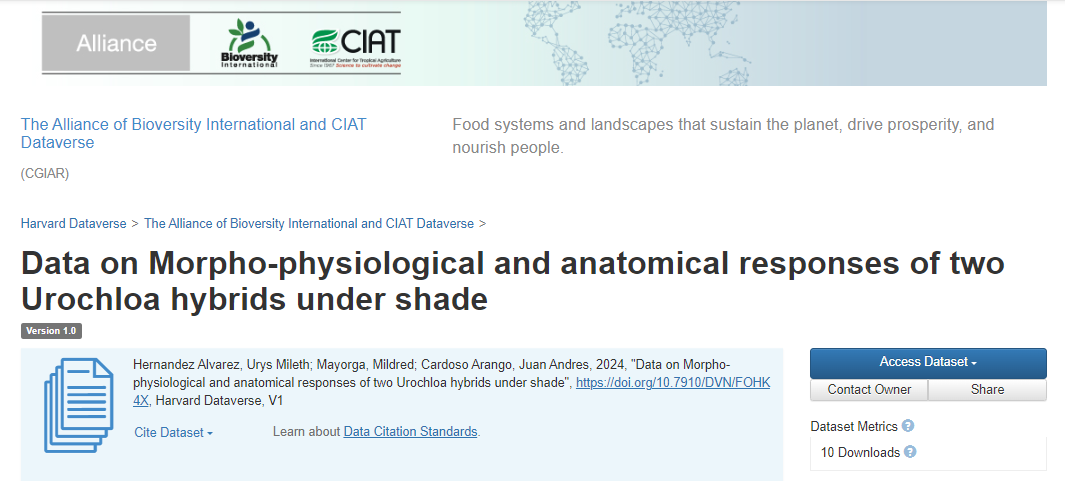Data on Morpho-physiological and anatomical responses of two Urochloa hybrids under shade
The selection of Urochloa forage grasses that can grow under shaded environments is a critical step for the deployment of silvopastoral systems across the tropics. Plants growing in shaded environments show changes in morpho-physiological and anatomical traits for their acclimation under such conditions. Camello and Talisman are two Urochloa hybrids whose responses under shaded environments are unknown. For that purpose, a field trial was established in the Americas hub of The Alliance of Bioversity International and CIAT (Palmira, Colombia). Morpho-physiological and anatomical changes in plants after growth under shade (28% of light) vs. no shade (100% light) for 18 weeks were recorded. This is information is useful for the identification of constitutive or plastic traits associated with shade avoidance/tolerance in these two Urochloa hybrids and for their potential use in silvopastoral systems.
Metodology:Site descriptions: The field and laboratory evaluations were carried out on the Bioversity- Alliance Campus- located in Palmira Valle del Cauca 3 ° 50′ 38 ″ N - 76 ° 35′ 36 ″ W. In the months of August to November 2023. Trial design, treatments, and management. A factorial combination of two genotypes (Talisman and Camello) by two shading conditions (shade and no-shade) in a three-replicate complete randomized block was established. Each replicate was a plot of 2.25 m2 containing 25 plants, the space between plants was 0.3 m and between replicas at 2 m.
Morphological and agronomic traits: Plant height (PH) from the base to the end of the plant, leaf length (LL), leaf width (LW), leaf area (LA), plant cover (PC), and dry matter (DM) were measured. Tillers for plant (T) were counted.
Anatomical traits: Transversal cuts were made using a vibrating blade microtome and the relative tissue proportion was measured: adaxial epidermis (Ad.Ep), abaxial epidermis (Ab.Ep), vascular tissue (VT), sclerenchyma (S), bulliform cells (BC), kranz sheath (KS), colourless parenchyma (CP), Chlorenchyma (C). Chlorenchyma was calculated by the difference between the total area and the area of the above tissues. Images were analyzed using ImageJ (Image Processing and Analysis in Java). The proportions of the different types of tissue were expressed as a percentage of the transversal section.
Physiological traits: Relative chlorophyll concentration (RCC) was measured using Spad and stoma length (SL) was measured using a light microscope. Images were analyzed using ImageJ.
Root morphological traits: Plants were grown in tubes of 1.1 m depth. After seven weeks of planting, the cover tube was removed, and a photograph of the root was taken on each of the two sides of the tube. Images were segmented using ImageJ and analyzed in RhizoVision Explorer to obtain root length (RL), root diameter (RD), root volume (RV), and root surface area (RSA) data. D95 was calculated as the depth above which 95% of root surface area occurred.

